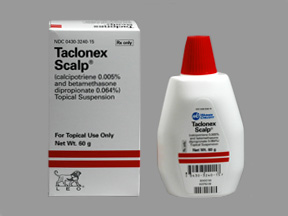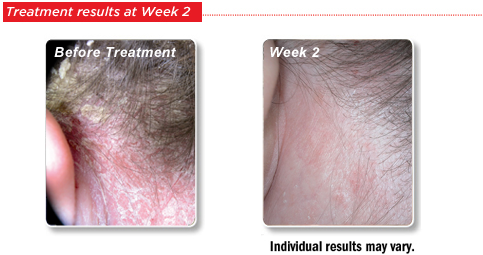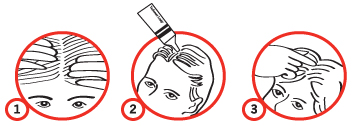
Taclonex Scalp
calcipotriene/betamethasone dipropionate topical

Entire Monograph
Adult Dosing
Dosage forms: 0.005%/0.0643% susp
psoriasis, mod-severe scalp
[apply qd x2wk or until clear]
Max: 100 g/wk x8wk; Info: do not use on face, axillae, groin; do not use occlusive dressing
Peds Dosing
Peds dosing is currently unavailable or not applicable for this drug.
Contraindications/Cautions
- calcium metabolism disorders
- erythrodermic psoriasis
- exfoliative psoriasis
- pustular psoriasis
- skin atrophy at site
- caution if skin infxn
- caution in pediatric pts
- caution if renal impairment, severe
- caution if hepatic impairment, severe
Drug Interactions
Avoid/Use Alternative
- anthralin topical
- vitamin D analogs
Monitor/Modify Tx
- ACE inhibitor/thiazide combos
- aliskiren/amlodipine/hydrochlorothiazide
- aliskiren/hydrochlorothiazide
- amlodipine/ARB/thiazide combos
- ARB/thiazide combos
- beta blocker/thiazide combos
- calcium salts
- diuretics, potassium-sparing/thiazide combos
- diuretics, thiazide
Adverse Reactions
Serious Reactions
- HPA axis suppression
- Cushing syndrome
- hyperglycemia
- intracranial HTN (peds pts)
- hypercalcemia
- skin atrophy
- tumorigenicity (animal studies)
Common Reactions
- pruritus
- headache
- nasopharyngitis
- psoriasis exacerbation
- irritation
- skin atrophy
- folliculitis
- burning
- hypopigmentation
- striae
- telangectasia
- dryness
- acneiform eruption
- perioral dermatitis
- allergic contact dermatitis
- secondary infxn
- miliaria
Safety/Monitoring
Pregnancy: C (Animal studies show adverse fetal effect(s) but no controlled human studies OR no animal or human studies; weigh possible fetal risk vs. maternal benefit; see pkg insert for drug-specific recs)
Lactation: Safety Unknown (Inadequate literature available to assess risk; caution advised)
Monitoring Parameters
Ca; cosyntropin stimulation test if large dose applied to large surface area
Pharmacology
Metabolism: see individual drugs
Excretion: see individual drugs
Subclass: Corticosteroids, Topical II: High Potency; Psoriasis, Topical
Mechanism of Action
see individual drugs
Manufacturer/Pricing
Manufacturer: LEO Pharma Inc.
DEA/FDA: Rx: (Requires prescription; not a controlled substance)
Approximate Retail Price
from www.drugstore.com
This information is currently not available for this drug.
Patient Education
- Generic Name: betamethasone and calcipotriene (topical)
- Pronounced: BAY ta METH a sone and KAL si poe TRYE een
- Brand Names: Taclonex, Taclonex Scalp
What is the most important information I should know about betamethasone and calcipotriene?
Use this medication exactly as it was prescribed for you. Do not use it in larger doses or for longer than recommended by your doctor.
Before using betamethasone and calcipotriene, tell your doctor if you are pregnant or breast-feeding.
If you miss a dose, use the medication as soon as you remember. If it is almost time for the next dose, skip the missed dose and wait until your next regularly scheduled dose. Do not use extra medicine to make up the missed dose.
There may be other drugs that can affect betamethasone and calcipotriene. Tell your doctor about all the prescription and over-the-counter medications you use. This includes vitamins, minerals, herbal products, and drugs prescribed by other doctors. Do not start using a new medication without telling your doctor.
Stop using this medication and get emergency medical help if you think you have used too much medicine, or if you have any of these signs of an allergic reaction: hives; difficulty breathing; swelling of your face, lips, tongue, or throat.
Less serious side effects are more likely, and you may have none at all. Talk to your doctor about any side effect that seems unusual or is especially bothersome.
What is betamethasone and calcipotriene?
Betamethasone is a topical corticosteroid. It reduces swelling, relieves itching, and constricts blood vessels.
Calcipotriene is a form of vitamin D. It works by decreasing the rate of skin cell reproduction.
Betamethasone and calcipotriene is a combination drug used to treat psoriasis vulgaris.
Betamethasone and calcipotriene may also be used for other purposes not listed in this medication guide.
What should I discuss with my healthcare provider before using betamethasone and calcipotriene?
Before using this medication, tell your doctor if you have:
- low or high levels of calcium in your blood;
- liver or kidney disease;
- severe forms of psoriasis (with pus, skin peeling, severe redness); or
If you have any of these conditions, you may not be able to use betamethasone and calcipotriene, or you may need a dose adjustment or special tests during treatment.
Tell your doctor if you are receiving UV light treatments (phototherapy) for your psoriasis.
FDA pregnancy category C. It is not known whether this medication is harmful to an unborn baby. Before using betamethasone and calcipotriene, tell your doctor if you are pregnant or plan to become pregnant during treatment.
It is not known if betamethasone and calcipotriene pass into breast milk or if this medicine could harm a nursing baby. Do not use this medication without telling your doctor if you are breast-feeding a baby.
This medicine should not be used on a child.
How should I use betamethasone and calcipotriene?
Use betamethasone and calcipotriene exactly as it was prescribed for you. Do not use it in larger doses or for longer than recommended by your doctor.
This medication comes with patient instructions for safe and effective use. Follow these directions carefully. Ask your doctor or pharmacist if you have any questions.
Wash your hands before and after applying this medicine.
Betamethasone and calcipotriene topical is for use on the skin only. However, do not apply the medicine to your face, underarms, or groin (genital area).
Shake the liquid form of this medication before using it.
Apply a thin layer of the medication and rub it in completely.
Do not cover treated skin areas with a bandage or tight clothing, unless your doctor has told you to.
Do not use betamethasone and calcipotriene for longer than 4 weeks unless your doctor has told you to.
While you are using this medication, your blood and urine may need to be tested on a regular basis. It is important that you not miss any scheduled visits to your doctor.
Store this medicine at room temperature away from moisture and heat. Keep the tube capped and tightly closed when not in use.
What happens if I miss a dose?
Use the medication as soon as you remember. If it is almost time for the next dose, skip the missed dose and wait until your next regularly scheduled dose. Do not use extra medicine to make up the missed dose.
What happens if I overdose?
Seek emergency medical attention if you think you have used too much of this medicine, or if anyone has accidentally swallowed it.
Overdose symptoms may include nausea, vomiting, lost appetite, tiredness, trouble breathing, joint/muscle pain, feeling light-headed, or fainting.
What should I avoid while using betamethasone and calcipotriene?
Avoid applying this medicine to more than one-third of your skin surface at any one time.
Avoid exposure to sunlight or artificial UV rays (sunlamps or tanning beds). Betamethasone and calcipotriene topical can make your skin more sensitive to sunlight and sunburn may result. Use a sunscreen (minimum SPF 15) and wear protective clothing if you must be out in the sun.
Avoid getting this medication in your eyes, mouth, and nose, or on your lips. If it does get into any of these areas, wash with water. Do not use this medicine on sunburned, windburned, dry, chapped, irritated, or broken skin; or on open wounds. Also avoid using this medication in wounds or on areas of infection. Wait until these conditions have healed before using betamethasone and calcipotriene topical.
What are the possible side effects of betamethasone and calcipotriene?
Get emergency medical help if you have any of these signs of an allergic reaction: hives; difficult breathing; swelling of your face, lips, tongue, or throat.
Stop using betamethasone and calcipotriene and call your doctor at once if you have any of these serious side effects:
- severe skin irritation on treated areas;
- worsened symptoms or no improvement in psoriasis;
- pus, swelling, redness, increased itching, or other signs of skin infection;
- confusion, thirst, extreme tiredness, lost appetite, weight loss;
- adrenal insufficiency--nausea, vomiting, lost appetite, tiredness, trouble breathing, joint/muscle pain, feeling light-headed, fainting;
- Cushing syndrome--weight gain (especially in your face), thinning muscles in your arms or legs, easy bruising, thinning skin, acne, increased facial hair, darkened skin; or
Less serious side effects may include:
- burning or mild itching;
- red or scaly rash;
- swollen hair follicles; or
This is not a complete list of side effects and others may occur. Call your doctor for medical advice about side effects. You may report side effects to FDA at 1-800-FDA-1088. You may report side effects to FDA at 1-800-FDA-1088.
What other drugs will affect betamethasone and calcipotriene?
Before using betamethasone and calcipotriene, tell your doctor if you are using any other steroid medicines, or other medicines to treat psoriasis.
There may be other drugs that can interact with betamethasone and calcipotriene. Tell your doctor about all the prescription and over-the-counter medications you use. This includes vitamins, minerals, herbal products, and drugs prescribed by other doctors. Do not start using a new medication without telling your doctor.
Where can I get more information?
Your pharmacist has more information about betamethasone and calcipotriene topical.
Remember, keep this and all other medicines out of the reach of children, never share your medicines with others, and use this medication only for the indication prescribed.
Every effort has been made to ensure that the information provided by
Cerner Multum, Inc. ('Multum') is accurate, up-to-date, and complete, but no
guarantee is made to that effect. Drug information contained herein may be time
sensitive. Multum information has been compiled for use by healthcare
practitioners and consumers in the United States and therefore Multum does not
warrant that uses outside of the United States are appropriate, unless
specifically indicated otherwise.
Multum's drug information does not endorse drugs, diagnose patients or
recommend therapy. Multum's drug information is an informational resource
designed to assist licensed healthcare practitioners in caring for their
patients and/or to serve consumers viewing this service as a supplement to, and
not a substitute for, the expertise, skill, knowledge and judgment of
healthcare practitioners. The absence of a warning for a given drug or drug
combination in no way should be construed to indicate that the drug or drug
combination is safe, effective or appropriate for any given patient. Multum
does not assume any responsibility for any aspect of healthcare administered
with the aid of information Multum provides.
The information contained herein is not intended to cover all possible uses,
directions, precautions, warnings, drug interactions, allergic reactions, or
adverse effects. If you have questions about the drugs you are taking, check
with your doctor, nurse or pharmacist.
How to use
To treat your scalp plaque psoriasis, apply a thin layer of Taclonex Scalp® (calcipotriene 0.005% and betamethasone dipropionate 0.064%) Topical Suspension to the affected areas once daily. Remember to use Taclonex Scalp® only as prescribed by your dermatologist or healthcare provider. Taclonex Scalp® is for topical use only.
- 1. Part your hair.
- 2. Shake the bottle and apply Taclonex Scalp® to affected areas of your scalp.
- 3. Gently rub Taclonex Scalp® into your skin using your fingertips.






 留言列表
留言列表
 線上藥物查詢
線上藥物查詢 